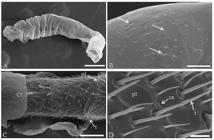Abstract
The antennal sensilla are sensory organs formed by a group of neurons and accessory cells, which allow perception of environmental cues, which play a role as mechanoreceptors and chemoreceptors. This study describes the post-embryonic development of the antennal sensilla of the stingless Tetragonisca angustula (Hymenoptera: Meliponini) workers. The development of the antennal sensilla begins in the transition stage of the pre-pupae to white-eyed pupae. The sensilla are completely developed at the black-eyed pupae stage, but they are covered by the old cuticle. The sensilla are exposed to the environment only in newly emerged workers of T. angustula, but it is possible that environmental stimuli can be recognized due to the pores in the old cuticle.
Keywords:
placoid sensilla; trichodea sensilla; stingless bee; pupal development

 Thumbnail
Thumbnail
 Thumbnail
Thumbnail

